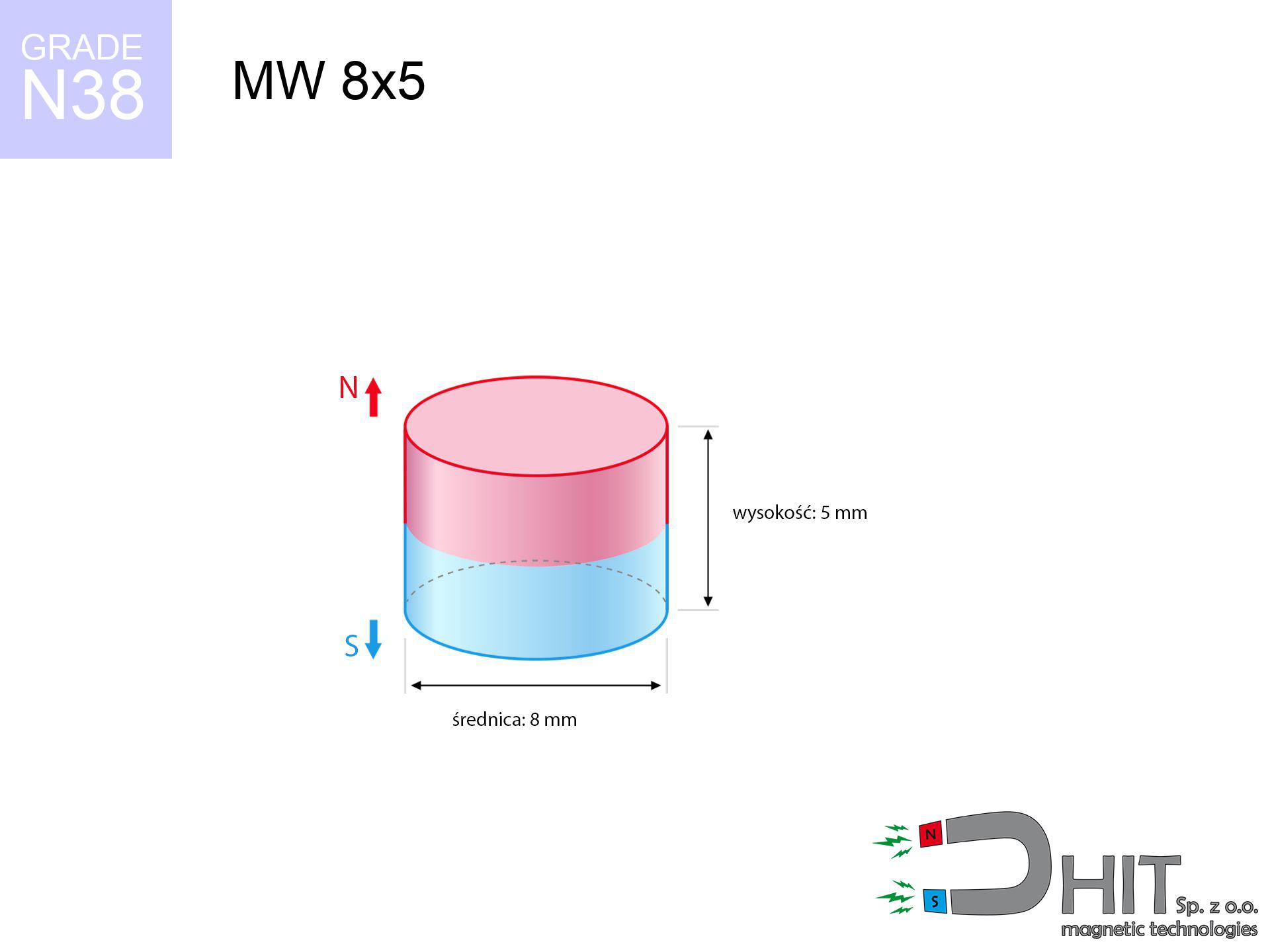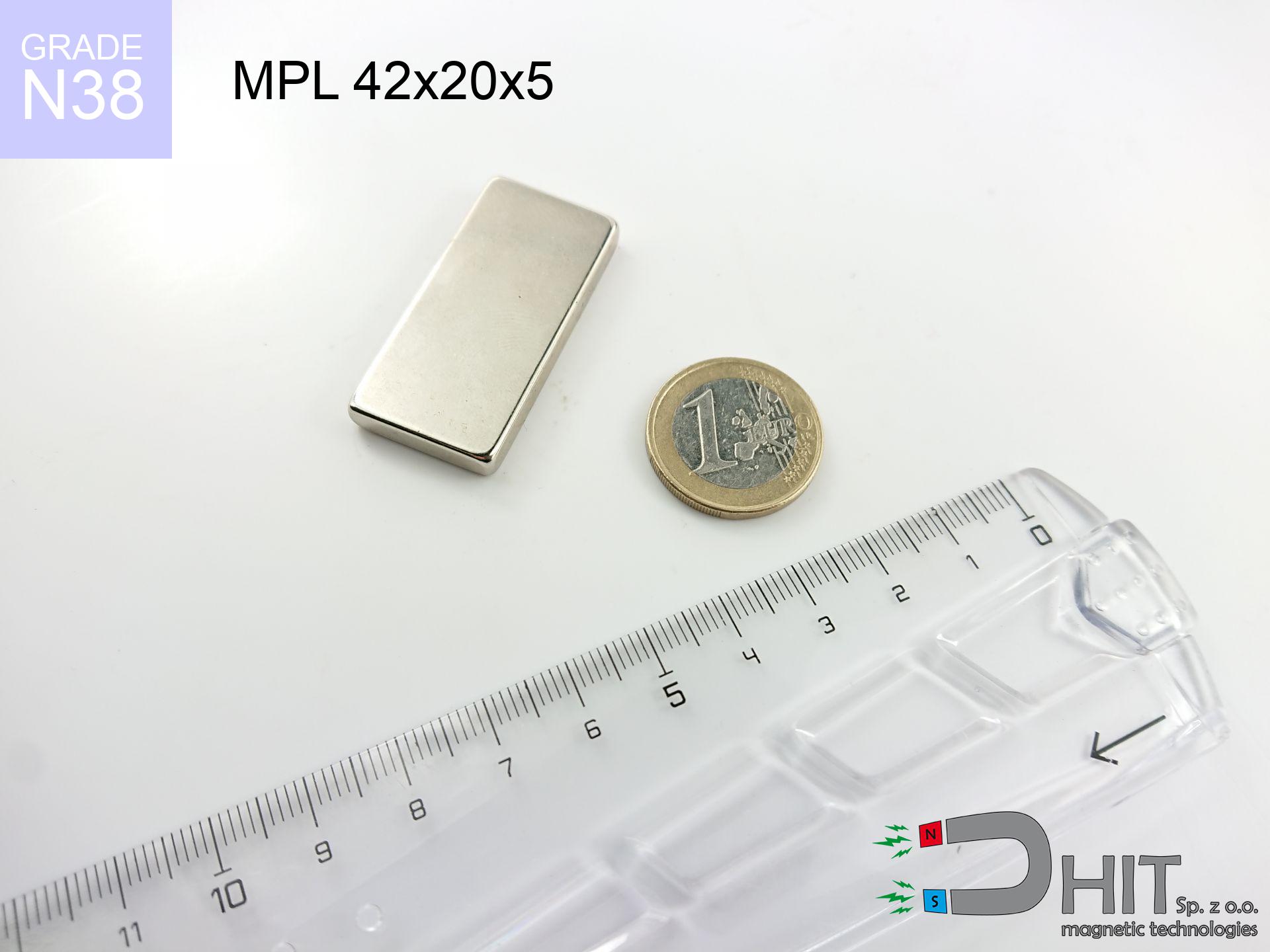MW 8x5 / N38 - cylindrical magnet
cylindrical magnet
Catalog no 010105
GTIN: 5906301811046
Diameter Ø [±0,1 mm]
8 mm
Height [±0,1 mm]
5 mm
Weight
1.88 g
Magnetization Direction
↑ axial
Load capacity
2.21 kg / 21.67 N
Magnetic Induction
483.41 mT
Coating
[NiCuNi] nickel
0.836 ZŁ with VAT / pcs + price for transport
0.680 ZŁ net + 23% VAT / pcs
bulk discounts:
Need more?Not sure about your choice?
Call us now
+48 888 99 98 98
if you prefer drop us a message by means of
form
the contact form page.
Force along with form of magnetic components can be verified on our
our magnetic calculator.
Orders placed before 14:00 will be shipped the same business day.
Magnetic properties of material N38
Physical properties of sintered neodymium magnets Nd2Fe14B at 20°C
Shopping tips
Strengths as well as weaknesses of neodymium magnets.
In addition to their long-term stability, neodymium magnets provide the following advantages:
- They have unchanged lifting capacity, and over more than 10 years their performance decreases symbolically – ~1% (according to theory),
- They are extremely resistant to demagnetization induced by external field influence,
- The use of an elegant layer of noble metals (nickel, gold, silver) causes the element to be more visually attractive,
- Magnetic induction on the working part of the magnet is extremely intense,
- Due to their durability and thermal resistance, neodymium magnets can operate (depending on the shape) even at high temperatures reaching 230°C or more...
- Possibility of custom creating as well as modifying to individual applications,
- Versatile presence in electronics industry – they are utilized in hard drives, electromotive mechanisms, precision medical tools, as well as technologically advanced constructions.
- Relatively small size with high pulling force – neodymium magnets offer strong magnetic field in compact dimensions, which allows their use in miniature devices
Characteristics of disadvantages of neodymium magnets: weaknesses and usage proposals
- Brittleness is one of their disadvantages. Upon strong impact they can fracture. We recommend keeping them in a steel housing, which not only secures them against impacts but also raises their durability
- We warn that neodymium magnets can reduce their power at high temperatures. To prevent this, we advise our specialized [AH] magnets, which work effectively even at 230°C.
- Due to the susceptibility of magnets to corrosion in a humid environment, we suggest using waterproof magnets made of rubber, plastic or other material stable to moisture, when using outdoors
- We recommend casing - magnetic mount, due to difficulties in creating nuts inside the magnet and complex forms.
- Potential hazard resulting from small fragments of magnets are risky, if swallowed, which is particularly important in the context of child health protection. Furthermore, tiny parts of these magnets are able to be problematic in diagnostics medical in case of swallowing.
- With large orders the cost of neodymium magnets can be a barrier,
Magnetic strength at its maximum – what contributes to it?
The specified lifting capacity refers to the limit force, recorded under laboratory conditions, meaning:
- using a sheet made of low-carbon steel, acting as a ideal flux conductor
- possessing a thickness of minimum 10 mm to avoid saturation
- with an ideally smooth contact surface
- with zero gap (no paint)
- for force applied at a right angle (in the magnet axis)
- at temperature approx. 20 degrees Celsius
Impact of factors on magnetic holding capacity in practice
Holding efficiency is influenced by working environment parameters, including (from priority):
- Gap between surfaces – every millimeter of separation (caused e.g. by veneer or unevenness) drastically reduces the magnet efficiency, often by half at just 0.5 mm.
- Loading method – declared lifting capacity refers to pulling vertically. When applying parallel force, the magnet exhibits much less (often approx. 20-30% of maximum force).
- Plate thickness – too thin sheet causes magnetic saturation, causing part of the power to be escaped to the other side.
- Chemical composition of the base – mild steel attracts best. Alloy steels decrease magnetic properties and lifting capacity.
- Surface condition – ground elements guarantee perfect abutment, which improves field saturation. Rough surfaces reduce efficiency.
- Temperature influence – high temperature reduces magnetic field. Exceeding the limit temperature can permanently damage the magnet.
* Lifting capacity testing was carried out on a smooth plate of suitable thickness, under perpendicular forces, however under shearing force the holding force is lower. Additionally, even a small distance {between} the magnet and the plate decreases the lifting capacity.
Safety rules for work with NdFeB magnets
GPS Danger
Remember: neodymium magnets produce a field that interferes with sensitive sensors. Keep a safe distance from your mobile, device, and GPS.
Magnets are brittle
NdFeB magnets are ceramic materials, which means they are fragile like glass. Impact of two magnets leads to them cracking into small pieces.
Serious injuries
Big blocks can smash fingers in a fraction of a second. Never place your hand betwixt two attracting surfaces.
Keep away from computers
Data protection: Neodymium magnets can ruin payment cards and sensitive devices (pacemakers, medical aids, timepieces).
Respect the power
Before use, check safety instructions. Sudden snapping can destroy the magnet or hurt your hand. Think ahead.
Permanent damage
Control the heat. Exposing the magnet to high heat will destroy its magnetic structure and pulling force.
Mechanical processing
Fire warning: Neodymium dust is highly flammable. Do not process magnets without safety gear as this may cause fire.
Allergic reactions
It is widely known that the nickel plating (the usual finish) is a potent allergen. If you have an allergy, refrain from direct skin contact and choose coated magnets.
Adults only
These products are not intended for children. Swallowing multiple magnets may result in them attracting across intestines, which poses a direct threat to life and requires immediate surgery.
Danger to pacemakers
Health Alert: Strong magnets can turn off pacemakers and defibrillators. Stay away if you have medical devices.
Warning!
Need more info? Check our post: Are neodymium magnets dangerous?




![SM 25x275 [2xM8] / N42 - magnetic separator SM 25x275 [2xM8] / N42 - magnetic separator](https://cdn3.dhit.pl/graphics/products/sm-25x275-2xm8-boc.jpg)

![SM 25x325 [2xM8] / N42 - magnetic separator SM 25x325 [2xM8] / N42 - magnetic separator](https://cdn3.dhit.pl/graphics/products/sm-25x325-2xm8-man.jpg)


